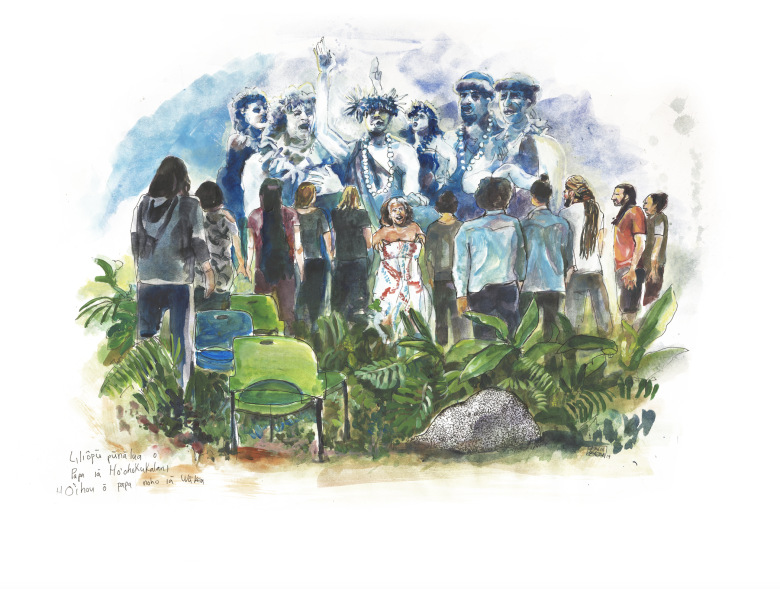
The above illustration is by Sergio Garzon, who was hired by Concordia University to document the winter 2020 Indigenous Protocol and AI Workshops through paintings and illustrations. Many of the workshop participants helped to develop the proposal for the Abundance Intelligences research project and are now on the research team.
OCAD University’s President Emerita Dr. Sara Diamond is a member of an international, interdisciplinary research team that will explore how Indigenous communities and artificial intelligence (AI) scientists can mutually benefit by augmenting the frameworks of Indigenous knowledge with innovative AI technologies.
The project, Abundant Intelligences: Expanding Artificial Intelligence through Indigenous Knowledge Systems, is being supported by a grant of nearly $23 million from the New Frontiers of Research Fund for six years.
The grant was awarded to Concordia University Professor Jason Edward Lewis who will co-lead the international, interdisciplinary team of experts, which includes Dr. Diamond who is a member of the project’s Steering Committee. Lewis is the Concordia University Research Chair in Computational Media and the Indigenous Future Imaginary, and a professor in the Department of Design and Computation Arts.
The Indigenous-led project involves 37 co-investigators and collaborators, the majority being Indigenous researchers and community members. It also includes eight universities, including OCAD U, and 12 Indigenous community-based organizations from Canada, the United States and New Zealand.
AI is the simulation of human intelligence by computer systems. It is becoming the next massive global, technological transformation, considered on par with the invention of the internet and the industrial revolution. As such, the funding for this project is crucially timed.
“Abundant Intelligences will result in innovative technologies and algorithms that will address pressing issues within Indigenous communities as well as new cultural expressions that share discoveries,” says Dr. Diamond.
Building abundance into AI development
According to Lewis, the current trajectory of AI development prioritizes Western ways of thinking about humans and our world. Developers see users foremost as individuals who prioritize personal well-being while ignoring vital aspects of human existence such as trust, care and community.
“We want to expand how we define AI while we build it. The plan is to explore a more extensive spectrum of intelligent human and non-human behaviours that we use to make sense of the world, “ he says.
To counter AI’s current model, the project will use what is known as Abundant Intelligences as a guiding principle.
“We use abundant intelligences because ‘abundant’ implies both diversity and knowledge practices that contribute to thriving networks of being in a particular place,” explains Hēmi Whaanga, co-principal investigator and a professor at Te Pūtahi a Toi School of Māori Knowledge at Massey University in New Zealand.
“These practices focus on regeneration, generosity and reciprocity. ‘Abundant’ signals a multitude of potential futures as well as an expansion of the narrow definitions of intelligence.”
A project rooted in integration, imagination and intelligence
Abundant Intelligences will mobilize an international and interdisciplinary team of experts. The teams will coalesce in locally rooted “pods” to collaborate with Indigenous communities. In this way, each team will learn from — and alongside — Indigenous knowledge keepers to bring novel perspectives to transforming AI.
The program is composed of three main axes:
The Integration Axis explores how Indigenous knowledge practices and frameworks can be synthesized with the mainstream knowledge frameworks used by AI researchers.
The Imaginaries Axis develops future imaginaries and speculative designs of Indigenous AI to guide the design of novel AI systems better suited to Indigenous flourishing.
The Intelligence Axis brings Indigenous perspectives to bear on technical challenges currently facing mainstream AI research. It also attempts to better understand ways of translating the full range of human intelligence into machine intelligence.
“Abundant Intelligences will succeed by effectively sharing Indigenous knowledge systems and methods and worldviews and methods from AI and domain science, exploring differences and convergences,” says Dr. Diamond.
“Participants will work towards a common language, and the ability to collaborate effectively, inventing new methods and knowledge. Knowledge and methods will be implemented, evaluated and refined through the intensive research projects that emerge within Abundant Intelligences,” she says.
To realize this, Dr. Diamond will help to lead the integration of visualization, play a prominent role in the Integration Axis, and participate in the Imagination and Intelligences Axes.
Source: Christian Durand, Concordia University